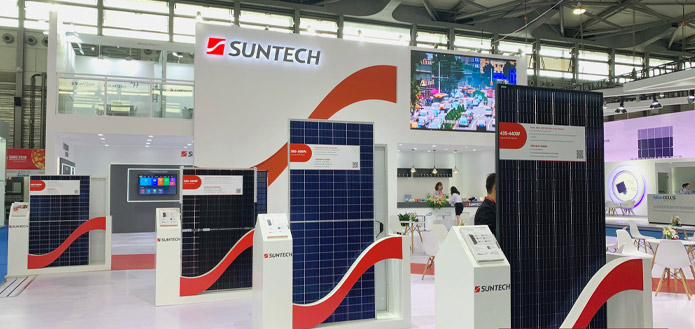Suntech has participated in SNEC for many years in succession. Devoted to driving the early realization of “grid parity” in PV power generation and with a view to the white-hot competition trend in the industry, Suntech has continuously pursued the reduction of module cost, strengthened the R&D of new technologies and improvement of production processes, and committed our efforts to the development and upgrading of new high-efficiency modules by depending on our excellent technical advantages and advanced manufacturing levels. The 8 modules exhibited by Suntech this time involve different power dimensions, different application scenarios, and even include multiple high power modules above 400w.
This is the 440w High-efficiency Mono PERC Half Cell Black Solar Module in the flagship Hipower series just launched on June 1, 2019. After repeated tests, comparison, and study by the technical team of Suntech, 158.75mm2 mono PERC cell is adopted in this module; compared with regular mono cell, it increases by 2mm in both length and width, with the cell in a complete square, effectively removes the sealing space of traditional mono modules, and increases the effective power generation area by 1.2% and the power of the module by an average of 8w; with a module conversion efficiency up to 20.4%, compared with products of the same specifications, it can provide higher power output, lower working temperature and higher peak power coefficient, which contributes to additional power generation gain for customers. Moreover, its black appearance matches more perfectly to the design aesthetics of modern products. Both the 78-cell large cell design and higher power density effectively reduce the installation area, save costs in labor and supporting structures, and maximize the photovoltaic system’s economic superiority and output power. An example is the 120MW project in southern Australia: with the common mono PERC half-cell 375W module adopted, LCOE is about 0.03 USD/kW·h; in contrast, with the HIPower Max 440W module is adopted, LCOE can be reduced by up to 6%. In conclusion of the technical advantages mentioned above, with outstanding cell technologies and leading encapsulation process, this module enjoys a maximum power up to 440w. The debut of this product on SNEC symbolizes that the formal launching of ultra-high-power modules of Suntech on the market, and it is another masterpiece of module 4.0 generation.
This module adopts the N-type high-efficiency mono bifacial PERT cell, with the maximum power gain on the back of the module reaching up to 30%; at the same time, its adoption of the symmetric design of N-type bifacial cells allows it to completely eradicate internal stress and greatly reduce the occurrence of micro-cracks; moreover, N-type module is free from LID features, which can effectively increase power generation. Since it has a low internal resistance loss in the outdoor power generation, and reduces the operating temperature of the module, the power generation capacity is increased by about 1% compared with the regular modules, thus effectively reducing the levelized cost of electricity (LCOE).
The Poly PERC 9BB Half Cell Solar Module has a power 10w higher than that of the regular 5BB module; since the density of grating lines increases and the space is small, even there are micro-cracks and chipson the cell, the power loss rate of multiple main grid cell can also decrease relatively and still keep a good performance of power generation. At the same time, its lower working temperature allows the module to produce higher output power.
This module adopts the bifacial PERC cell and combines the double-glass module technology, with the maximum power gain at the back of the module reaching up to 25%; its design of distributed junction box, allows the zero sheltering of the module’s back; moreover, its hall cell design reduces the series resistance, decreases the shading area and greatly increases the output power of the module.
The product’s glass is only 1.6mm+1.6mm in thickness and 16.9kg in weight; the seamless assembly of its integrated border suite endows it with an appearance of excellent design aesthetics and also allows it to effectively save the installation room. This product does not only achieve high attainments in appearance, but also shows good sustainability with its credible quality in severe environments, such as desert, farmland, and coast.
With the built-in smart optimization, the High-efficiency Smart DC Solar Module can reduce to the largest extent the mismatching of cell features incurred by shade, pollution, aging and improper roof orientation, and the resulting negative impacts, so as to ensure the maximum output power. This product enables flexible solutions in any environment and roof orientation.
The Self-cleaning Smart DC TG Solar Module adopts the design of anti-soiling coated glass and drainage frame, which enables the removing of stains and water stains on the surface of the module and ensures power output. Its good performance in impedance matching eliminates the influences incurred by module-level mismatching. The real time warning and web-page monitoring at the side of the module enhances the capacity of the system in normal operation and accurate positioning of trouble spots, to increase the maintenance efficiency of the system.
The High-efficiency Mono Shingling Module has a power 15% larger than that of regular module, and can reduce the system’s BOS cost and installation cost by 10%; its exquisite appearance design can effectively reduce the power loss caused by shadow.



 English
English
 中文
中文
